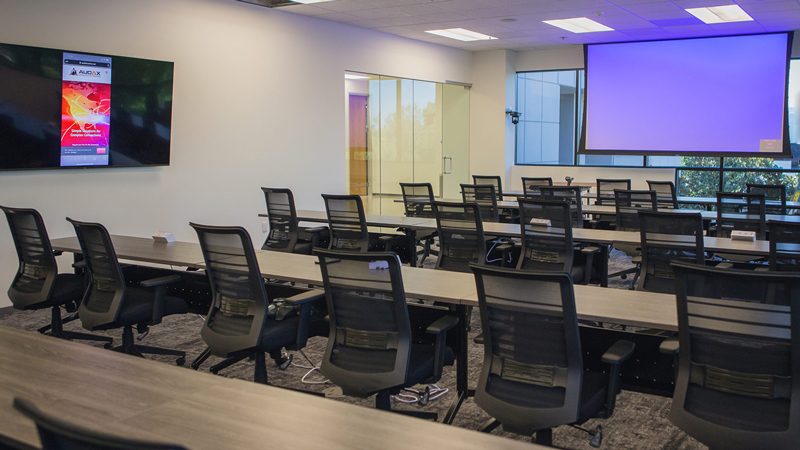Case Study: Irvine, CA
An Irvine-area medical group finds value in the network
for on-site and long-distance training
Download the Case Study PDF
The systems integrator is fundamentally programmed to handle jobs of any scale, and always receptive to new challenges. The majority of these jobs are renovations to existing facilities, many of which require some element of IP migration.
Renovations are fun and challenging jobs that ultimately bring end user clients into more efficient and effective AV environments. However, there is something satisfying about a ground-up construction – especially when the AV integrator is involved from the start.
Southern California-based Audax Communications is among the lucky firms that often find themselves in this position. One recent project involved the complete AV and IT buildout for a major healthcare organization in Irvine.
“We work with a lot of real estate developers and agencies that need a full-service integration firm that can cross multiple low-voltage jobs and integration phases,” said Mr. Magallon, Project Manager, Audax Communications. “We came into the build early and handled everything from structured wiring, optical, and network infrastructure through to access control, surveillance, and AV.”
The crown jewel from the AV perspective was a divisible, multipurpose conference and training room that could accommodate 50 or more medical professionals. That space would also serve as a basis for distance learning, with a soft codec conferencing infrastructure to communicate with facilities throughout the Americas and Europe.
Naturally, the end user also had cost on the mind. One mission was clear from the start, however.
“There was never a question that this was all going onto the network,” said Magallon. “We wanted a system that we could scale between some of the smaller huddle rooms and the larger conference spaces in the building. That made AV over IP the logical choice. The challenge for us was to build a technically superior solution that didn’t sacrifice quality for a lower price point.”
All roads led back to two key vendors: Atlona, which would supply the video routing, distribution and control; and Phoenix Audio, which would provide the core Dante-enabled DSP for audio and integration to soft codecs. The result is an All-IP Meeting Space that kept costs in check and offered a clean foundation for growth.
BEHIND THE WALLS
The integration team made the backbone its first order of business, selecting Cat6 shielded wiring and an Araknis managed switch. The structured wiring provides connectivity from the rack to all AV devices, while the switch reliably supports the multicast network architecture that Audax envisioned.
“The switch provides PoE power for the encoders and decoders, and the multicast configuration means it can easily handle the traffic that the encoders and decoders require to talk to each other,” said Magallon. “We wired everything locally to that switch, and from there we have an uplink to the main server room. That will allow the system to easily grow to other rooms and accommodate any future upgrades to existing rooms.”
The encoders and decoders that Magallon references are from Atlona’s OmniStream Pro AV over IP family. In fact, Atlona gear represents more than half of the equipment in the space, with single and dual-channel encoders (AT-OMNI-111, AT-OMNI-112), single-channel decoders (AT-OMNI-121), OmniStream USB over IP device adapters (AT-OMNI-311 USB-to-IP, AT-OMNI-324 IP-to-USB), an AT-HDVS-CAM camera, and Velocity networked AV control.
For audio, Magallon went straight for a Dante networking solution that could live on the same network. Same as on the video side, he had budget on the mind with the understanding that quality remained pertinent. And as time was at a premium, he wanted a system that was quick to configure and deploy. The Audax team leaned on Phoenix Audio’s Stingray DSP solution, which covered all of these bases.
“All audio is routed via Dante, including podium and ceiling microphones,” said Magallon. “The ease of installation with Phoenix is unsurpassed. We looked at other systems that are better-known brands, and great products just the same – but they lose out when it comes to programming intensity. With the Stingray, you power up and cycle it, adjust a few settings and you’re done. It was a 20-minute job to configure and deploy two Stingrays.”
“We wanted a system that we could scale”…”That made AV over IP the logical choice.”
– Mr. Magallon, Project Manager, Audax Communications
Open Freeway
The layout of the room is clean and wide open, with most of the technical infrastructure concealed from view. The main podium houses a microphone, keyboard, and a mouse on the surface, with a dual-channel OmniStream encoder and USB device adapter integrated within. One encoder channel is dedicated to the PC for presentations, with the second used to accommodate BYOD for the presenter.
Tables are dispersed throughout the space, each equipped with a single-channel OmniStream encoder that trainees can connect to. The decoders and other USB adapters are installed in the central rack. Video content is decoded and presented on a 90-inch display, as well as through an Optoma 4K ceiling projector that feeds a Da-Lite 130-inch motorized screen.
“Same as with the Stingray, we like OmniStream because we can easily move everything back to the network switch,” he said. “It’s a cleaner physical installation with less cabling, which means less man hours on the job. For the end user, the flexibility of the network architecture opens all kinds of collaborative opportunities. They can connect several individual training areas, or everyone in the space can work together. It provides a lot of freedom for the user.”
The Dante audio coming out of the switch – two Stingray DSP systems manage the audio flow in and out – is amplified by Atlona AT-GAIN-120 networked amplifiers. The amplified audio signals, which originate from Dante-enabled Shure MX202 ceiling microphones as well as embedded audio in the OmniStream systems, are then passed to JBL Control ceiling speakers for sound reinforcement. The JBL system is wired as a 70-volt configuration to accommodate the distance between the rack and the six ceiling speaker positions.

The audio clarity is critical given the long-distance training initiatives that take place on a regular basis. The Stingray DSP directly integrates with Zoom Rooms and GoToMeeting; Magallon designed custom macros for each.
“The training room and soft codec conferencing alleviate the costs of flying medical professionals and students in from other states and continents,” said Magallon. “We wanted to optimize the sound for these long-distance sessions. One of the first sessions was with a chief executive in Italy, and he commented about how crisp and clear they sounded. We initially thought that we would require some dampening or acoustical treatment inside the space, but once the furniture, carpet, and ceiling tiles were installed, the high quality of the audio system shined through.”
Atlona’s Velocity control system brings the entire ecosystem together by centralizing all AV control elements onto the network. Magallon called this choice the biggest cost-saver of the entire project, given the expense of other control systems on the market.
“There was literally no control system that offered better value for this installation,” said Magallon. “Velocity was far lower in price, it was plug-and-play, and scaling to other rooms moving forward is way simpler. It removes the traditional programming hassles as it’s all done over IP.”
Magallon’s Velocity configuration routes everything through a gateway to enable control, and includes fully customized rooms, scenes, and macros. He said the “miracle worker” of the system is the ability to treat the gateway as a network device.
“There is no need to run RGB and a mess of other legacy connections,” said Magallon. “It’s all IP and HDMI, and everything plugs right in. Configuration is easy as we can search for devices on the network. When we start adding OmniStream to the existing huddle spaces, we simply create a room, find the device and can replicate the same settings. We can have a new room online in half an hour.”
The general takeaway of an All-IP Meeting Space installation is that it reduces the costs for everyone involved, including labor expenses that would, in many cases, have been passed on to the end user.
“We probably saved a solid four days in pre-wiring alone, and then the equipment itself,” said Magallon. “If you compare the Stingray to other DSPs, there really is no comparison when it comes to price point and programming. Without Atlona’s OmniStream and Velocity, we may have been completely priced out of doing an AV over IP system here, based on the costs of the big-name competitors. The cost savings we passed on to the end user, coupled with the quality of the systems, has all but guaranteed that we will expand this system throughout this facility, and will allow us to do the same for a second facility in Texas.”
“We like OmniStream because we can easily move everything back to the network switch.”
– Magallon
| PRODUCTS FEATURED | ||
| Model | Description | Image |
| AT-OMNI-111 | The Atlona OmniStream™ 111 (AT-OMNI-111) is a single-channel networked AV encoder for HDMI sources up to 4K @ 60 Hz and HDR (High Dynamic Range), plus embedded audio and RS-232 or IR control pass-through. | 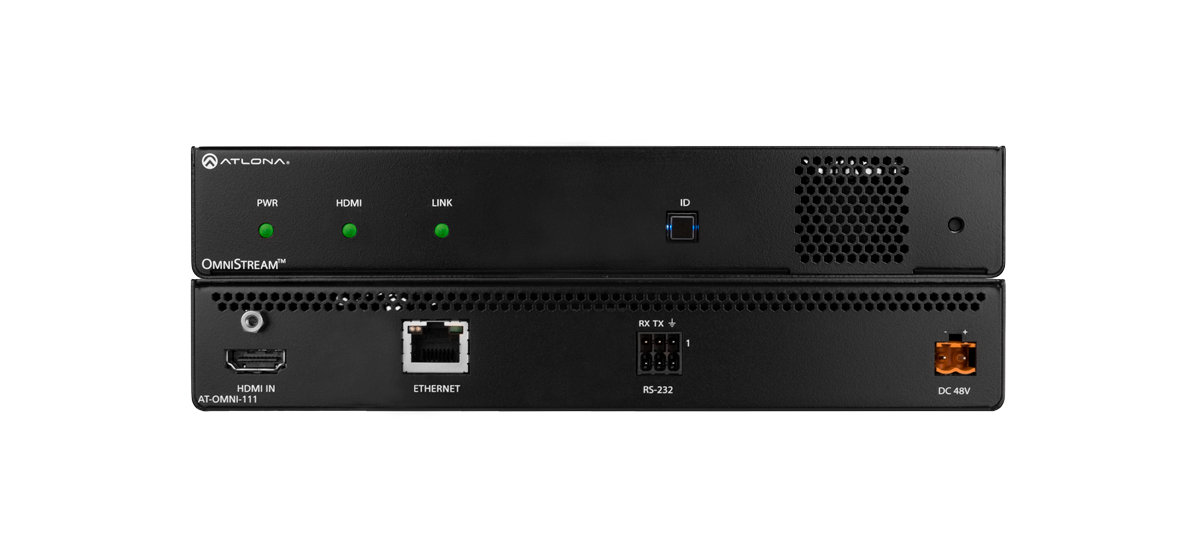 |
| AT-OMNI-112 | The Atlona OmniStream 112 (AT-OMNI-112) is a networked AV encoder with two independent channels of encoding for two HDMI sources up to 4K @ 60 Hz and HDR (High Dynamic Range), plus embedded audio and RS-232 or IR control pass-through. | 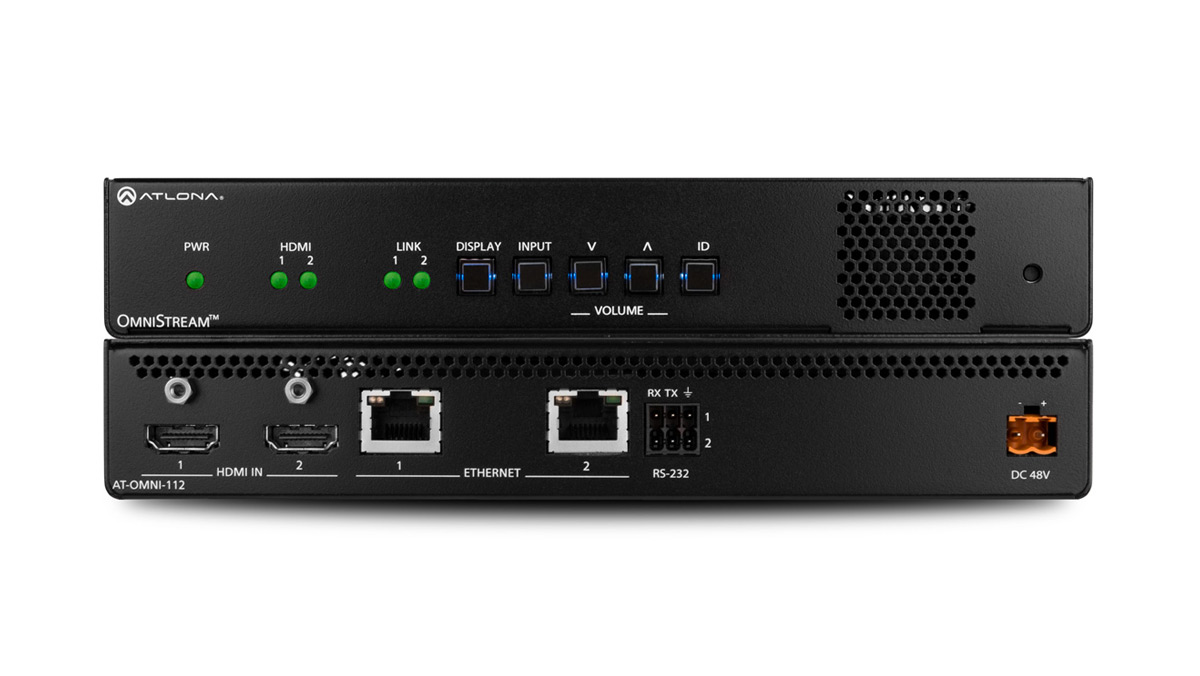 |
| AT-OMNI-121 | The Atlona OmniStream 121 (AT-OMNI-121) is a single-channel networked AV decoder for HDMI 2.0 / HDCP 2.2 output supporting resolutions up to 4K @ 60 Hz and HDR (High Dynamic Range), plus audio embedding and de-embedding, and RS-232 or IR control pass-through. | 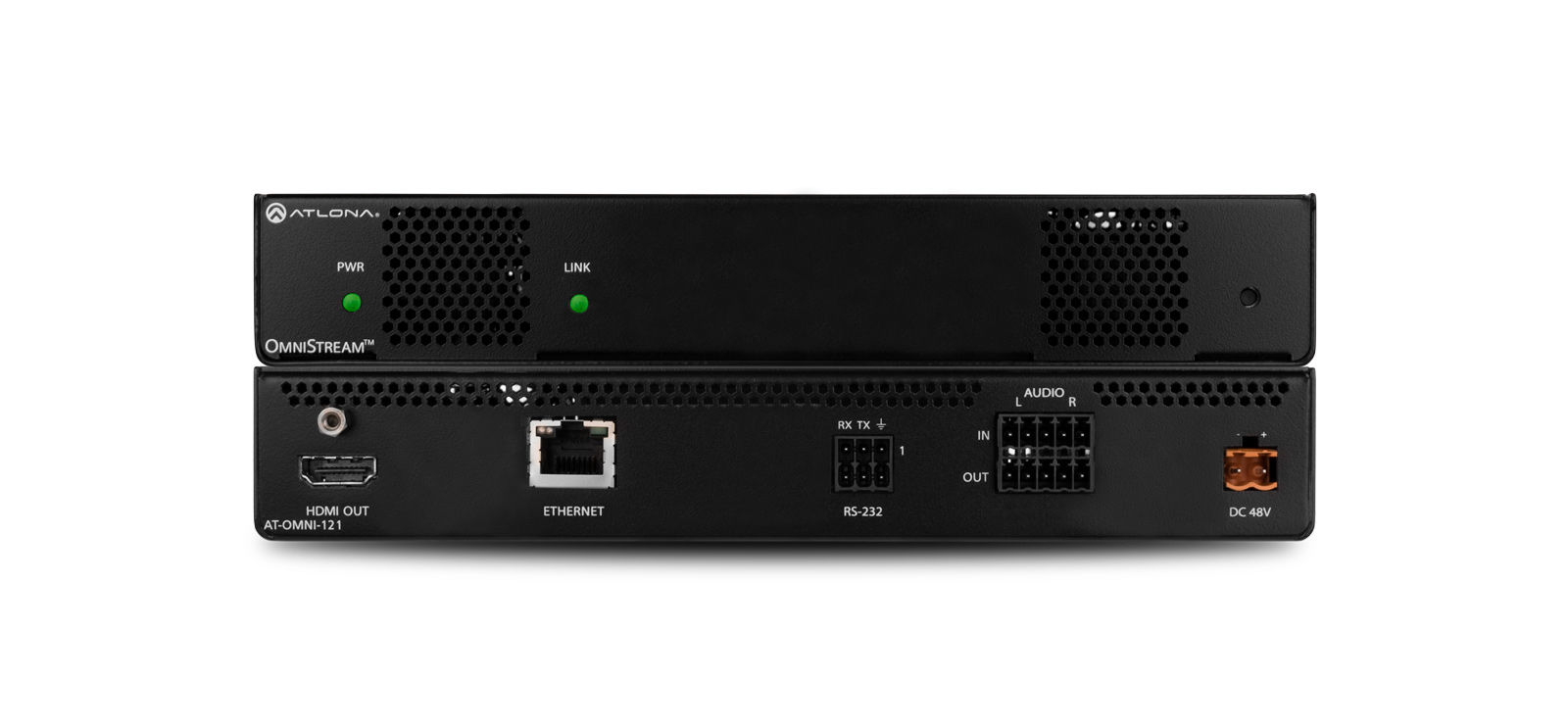 |
| AT-OMNI-311 | The Atlona OmniStream 311 (AT-OMNI-311) works in tandem with the OmniStream 324 (AT-OMNI-324) for extending USB from peripheral devices to a PC over Gigabit Ethernet. The OmniStream 311 interfaces with a PC or other host device, while the OmniStream 324 features a four-port USB hub for peripherals. |  |
| AT-OMNI-324 | The Atlona OmniStream 324 (AT-OMNI-324) works in tandem with the OmniStream 311 (AT-OMNI-311) for extending USB from peripheral devices to a PC over Gigabit Ethernet. The OmniStream 324 features a four-port USB hub for peripherals, while the OmniStream 311 interfaces with a PC or other host device. | 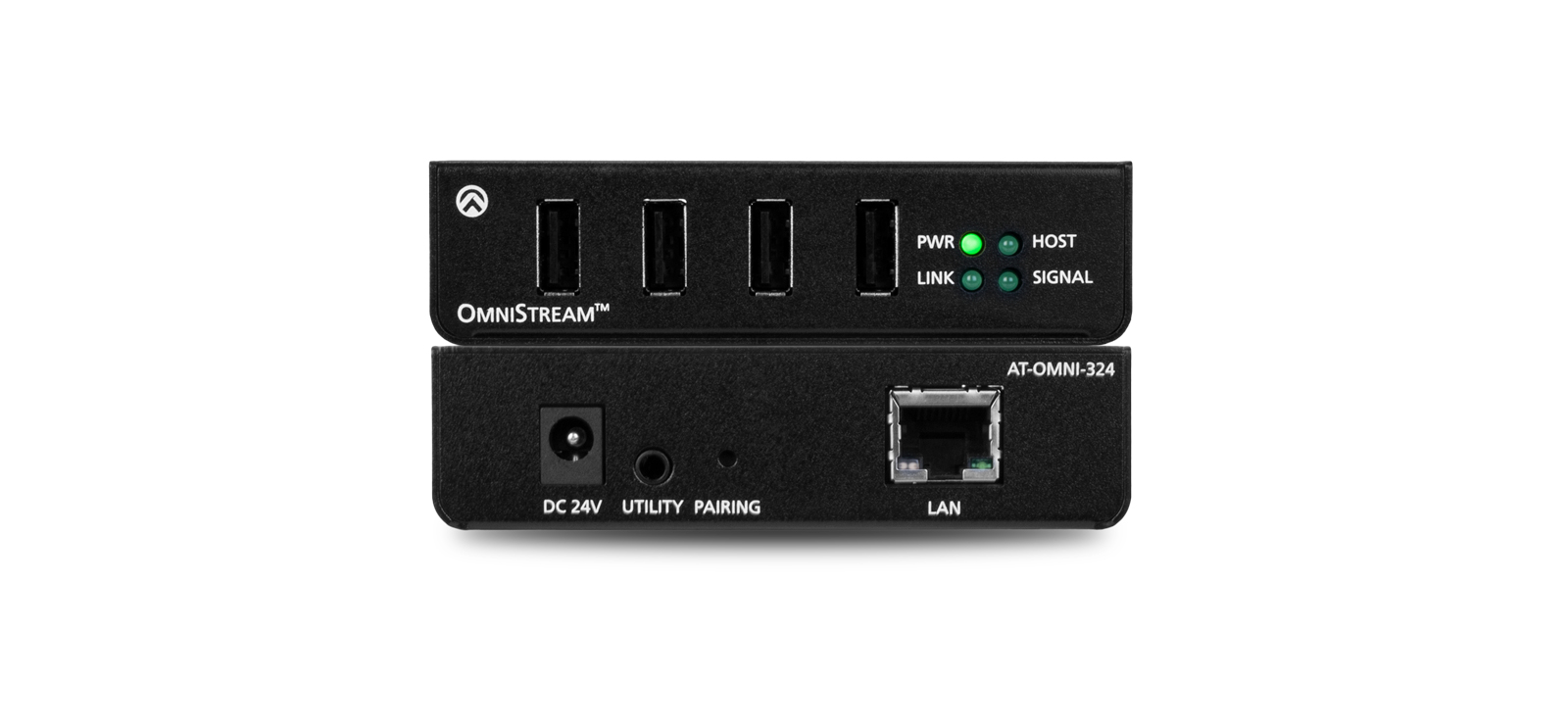 |
| AT-HDVS-CAM | The Atlona AT-HDVS-CAM is an enterprise-grade PTZ camera designed for use in video conferencing and other applications such as lecture capture and distance education. It features a USB 2.0 interface for video and camera control. | 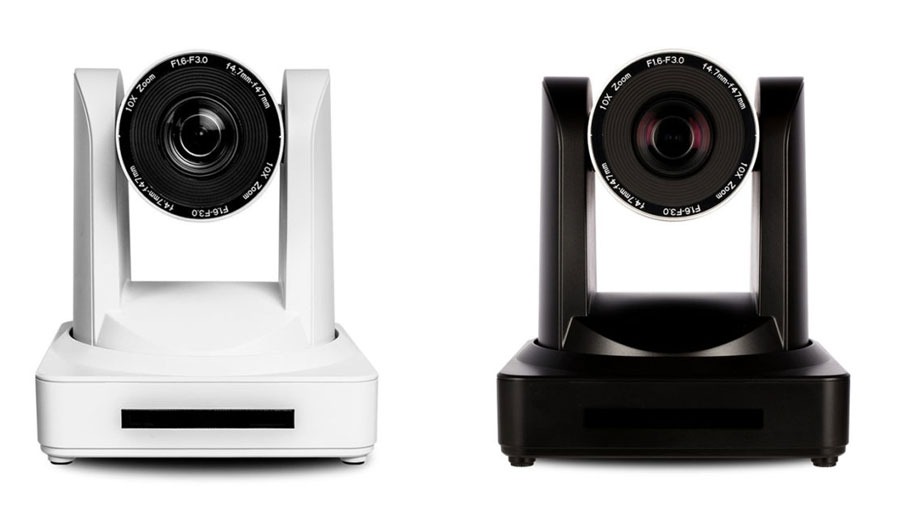 |
| VELOCITY AV CONTROL SYSTEM | Atlona Velocity is an innovative IP-based platform for AV control, room scheduling, and device management. Velocity allows a single, networked processor to serve multiple AV systems simultaneously, while providing the ability to configure or modify control systems in minutes, free of extensive programming. |  |
| AT-GAIN-120 | The Atlona Gain™ 120 (AT-GAIN-120) is a compact power amplifier designed for low or high impedance applications. A mode selector switch allows the Gain 120 to deliver two channels of 60 watts each into 4 or 8 ohms, or a single channel of 120 watts at 70 or 100 volts. | 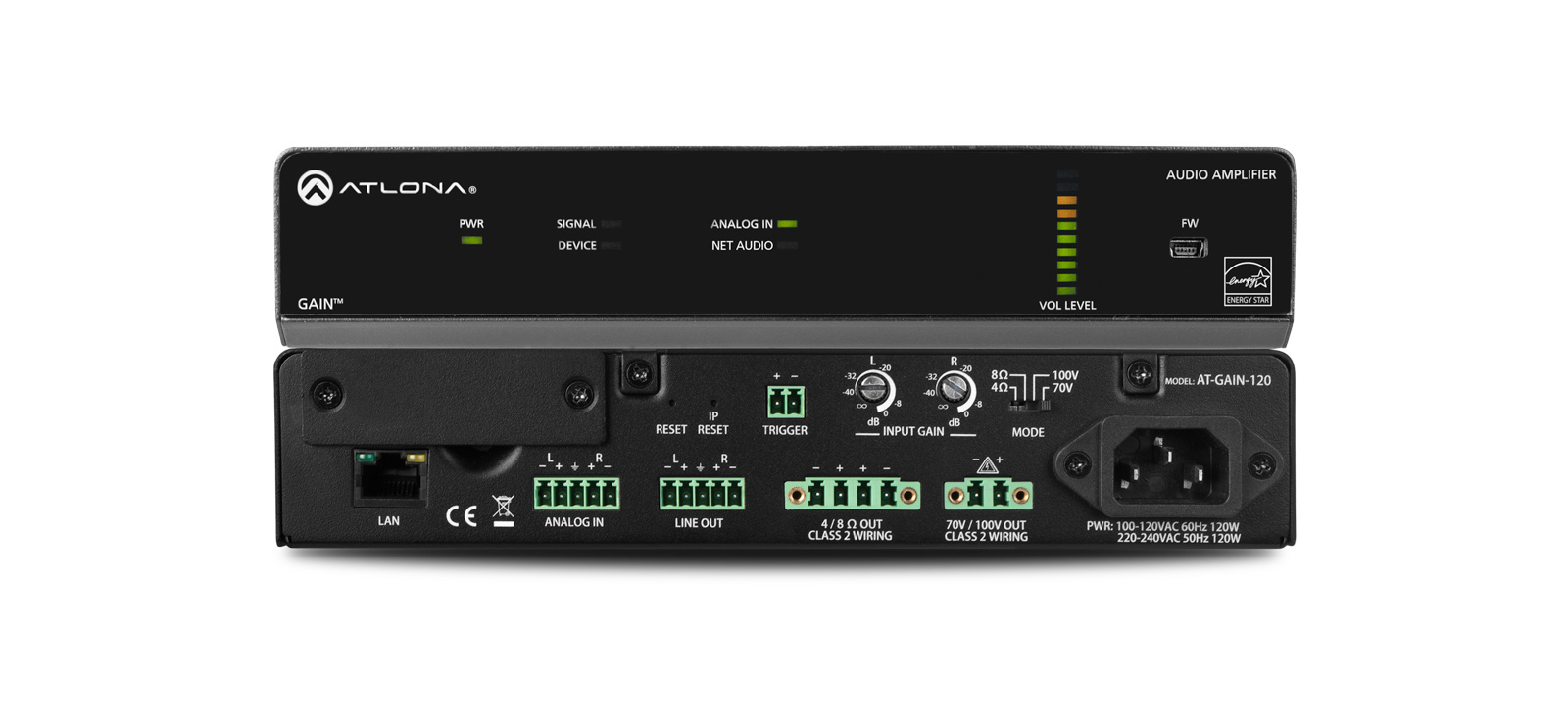 |
| AT-GAIN-NET | The Atlona AT-GAIN-NET is a networked audio interface card for the Gain 120 (AT-GAIN-120) power amplifier. It features an AES67 and Dante dual-channel audio bridge, adding the capability to accept two channels over a network from a Dante or AES67-equipped DSP, as well as Atlona OmniStream AV encoders. The GAIN-NET can easily be installed into a Gain 120 amplifier in the field. |  |







